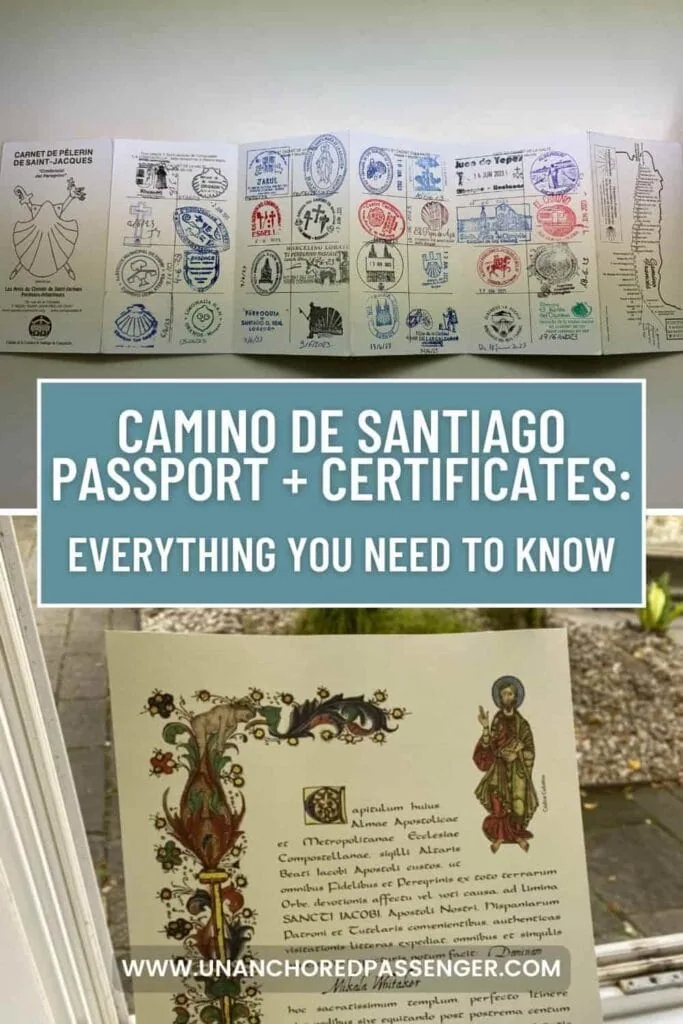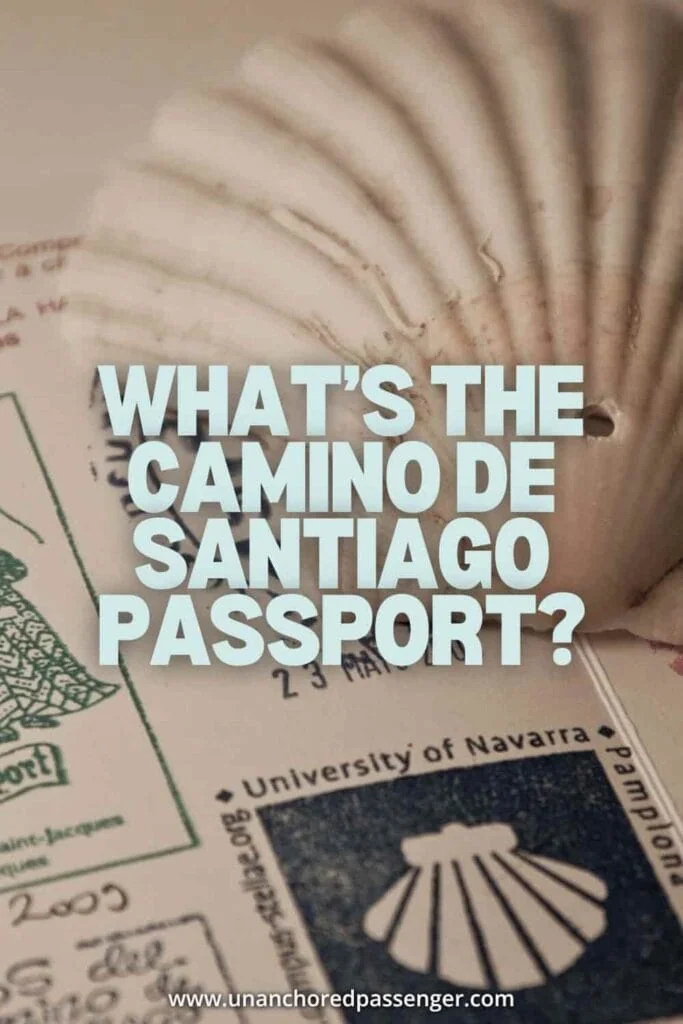Camino de Santiago Passport: All You Need to Know in 2025

The Camino de Santiago passport is one of the most important items pilgrims carry on their journeys. The passport identifies you as a pilgrim, which is required in many albergues (pilgrim hostels) and gets you discounts in some places. It also provides a way for you to document your Camino so you can get a special certificate when you finish.
Plus, the passport is it a fun way to commemorate your adventure! I hiked the Camino de Santiago last year and still love looking back at my passport and reminiscing on the experience.
This post will tell you everything you need to know about this important document as you plan your journey.
What is the Camino de Santiago Passport?
Similar to a passport you carry with you for travel, the Camino passport includes identifying information about you and space for stamps. The stamps each show a location and a date, allowing you to record and have proof of your journey.
Pilgrims typically carry their passports with them throughout their whole Camino, collecting stamps at various locations on their way to Santiago de Compostela. While the majority of pilgrims travel by foot, pilgrims traveling by bike or horse may also use pilgrim passports.
The first page in my pilgrim passport included space for my name, address, nationality, real passport number, date I started, and whether I was walking via foot or bicycle. I also included my Whatsapp number and recommend you do the same. That will help someone return your passport to you if you lose it.
The next page has some sort of statement from an official confirming that I was a pilgrim. The remaining pages leave room for stamps until you get to the back.
The back includes a map of the route. There’s also a page with a statement I signed in agreement to generally be respectful and to acknowledge that I understood the purpose of the passport:
- To get access to accommodations along the way but that I should provide a donation even if no payment is requested
- To receive a Compostela certificate at the end of my Camino if certain criteria are met (more on that below)
What is the Credencial?
Credencial is another term sometimes used to refer to the Camino de Santiago passport, or pilgrim passport. This is the word most often used in Spanish, so you’ll likely see or hear this while hiking through Spain.

What is the Digital Pilgrim Passport?
Several years ago, the Cathedral of Santiago introduced the digital credencial. You just download an app on your phone instead of having a print passport. Then you can scan QR codes at various locations to collect digital stamps.
While this exists, I can’t say anyone on my Camino used it. I didn’t know about it until writing this post. I would still recommend using the paper version of the credencial instead as it’s a nice keepsake and some places may not have a QR code option for a digital stamp.
Do You Need a Passport for the Camino de Santiago?
If you plan to hike the Camino de Santiago, you should get a passport. While it’s not technically a requirement, you won’t always be recognized as a pilgrim without it.
Many albergues will only allow pilgrims and will require you show your passport as proof. In addition, some churches and other attractions along the Camino will have discounts for pilgrims but typically require you to show your passport as well.
If you want a certificate at the end of your Camino, you’ll need a passport as proof of your journey.
How Do I Get a Camino de Santiago Passport?
There are several options for getting your pilgrim passport. Many pilgrims will get theirs once they’ve arrived to the starting point of their journeys. I personally did this, getting mine at the Pilgrim’s Office in Saint-Jean-Pied-de-Port before I started my hike along the Camino Francés.
If you’re picking up a passport book in Saint-Jean-Pied-de-Port, there can be long lines at the Pilgrim’s Office, especially if you’re hiking during a busy time of year. It was pretty quiet when I went though, so if you see it’s busy, you may want to try at another time if you have flexibility in your schedule.
Along the Camino, many albergues will also sell passport books. Another option is getting your pilgrim passport in advance through a pilgrim association. Americans can request a credencial in advance from American Pilgrims on the Camino.
When I got my passport, they gave me a big Ziploc bag to keep it in so it would be safe from rain. I don’t know if all places provide this with a passport, so it might be a good idea to include a large plastic bag on your list of things to pack. A sandwich bag size is too small–you’ll want a quart size bag at least.

How Much Does a Camino Passport Cost?
The Camino de Santiago passport typically costs around €2-3. Some locations will provide the passport for free but will typically encourage a donation in that instance.
The Pilgrim’s Office in Saint-Jean-Pied-de-Port where I started currently charges €2.
Why Do I Need to Get my Pilgrim Passport Stamped?
The stamps serve as proof of the distance you’ve traveled along the Camino. Most stamps will include the name of the city or town of the establishment. You or the person leaving the stamp will write the date in.
This is really only absolutely necessary if you want a certificate at the end. That said, it’s a fun way to keep track of where you’ve been and everyone does it.
Where Do I Get my Credencial Stamped?
You can get your Camino de Santiago passport stamped just about anywhere along the Camino. Albergues, bars, restaurants, and churches typically all have stamps. Some of your newfound friends may even create their own stamps!
There are so many places to get stamps, that you may have to be selective on where you get your stamps or your book may fill up too soon. Don’t fret if that happens though—you can always get a second Camino passport book if you need to.
My favorite stamps were actually from a little lemonade stand on the way to Puente la Reina and then at the post office in Burgos when I had to ship back some bad shoes (don’t make that mistake like me!). You never know what places will have a cool stamp. For that reason, I recommend carrying your Camino passport with you everywhere you go.
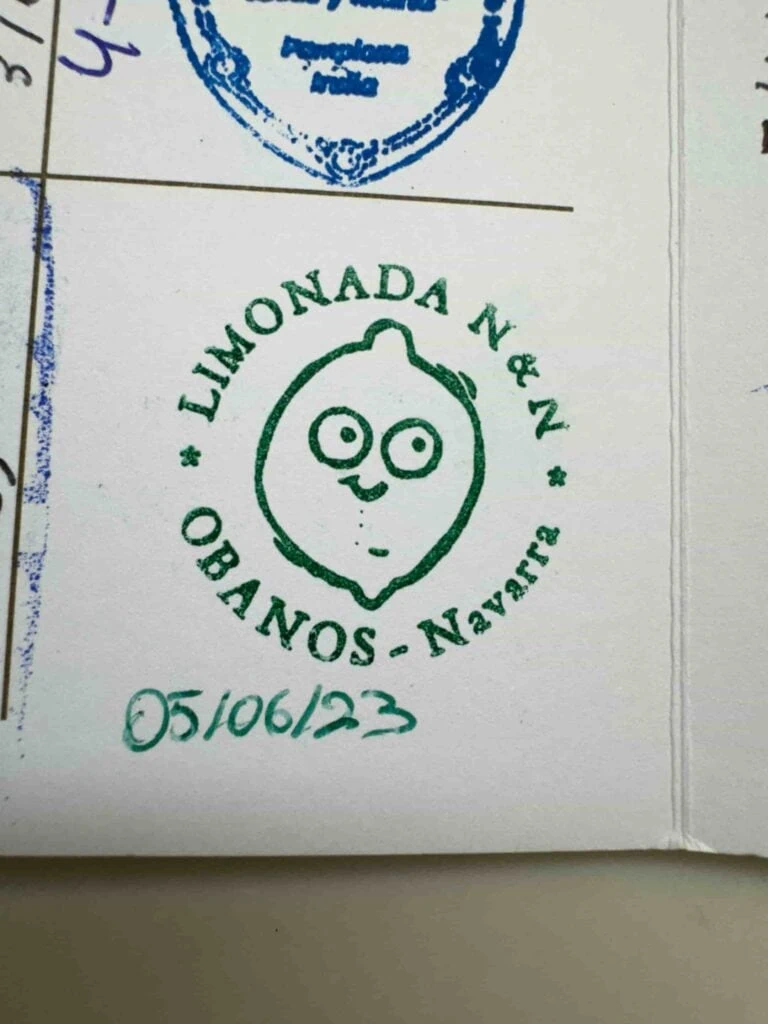

Does It Matter Where I Get my Passport Stamped?
It’s entirely up to you where you decide to collect stamps for your pilgrim passport. I recommend getting at least one each day for your own tracking, but you don’t have to if you don’t want to.
Some people might only get their passports stamped at albergues and churches. Others might get theirs stamped at albergues and cool restaurants or bars. Many people get a mix of stamps, but it’s yours to make of it what you want.
On an average day on the Camino, I usually got one to three stamps: one from my albergue, and one or two more from other unique locations, like a church or a cool bar.
Note that it’s generally appreciated to give a little money to wherever you’re getting a stamp, whether you’re purchasing something or making a donation.
How Many Stamps Will Fit in the Camino de Santiago Passport?
Each pilgrim passport book is different, but generally you can expect room for plenty of stamps, even if you’re on your journey for around a month. My passport book that I got at Saint-Jean-Pied-de-Port included space for 72 stamps.
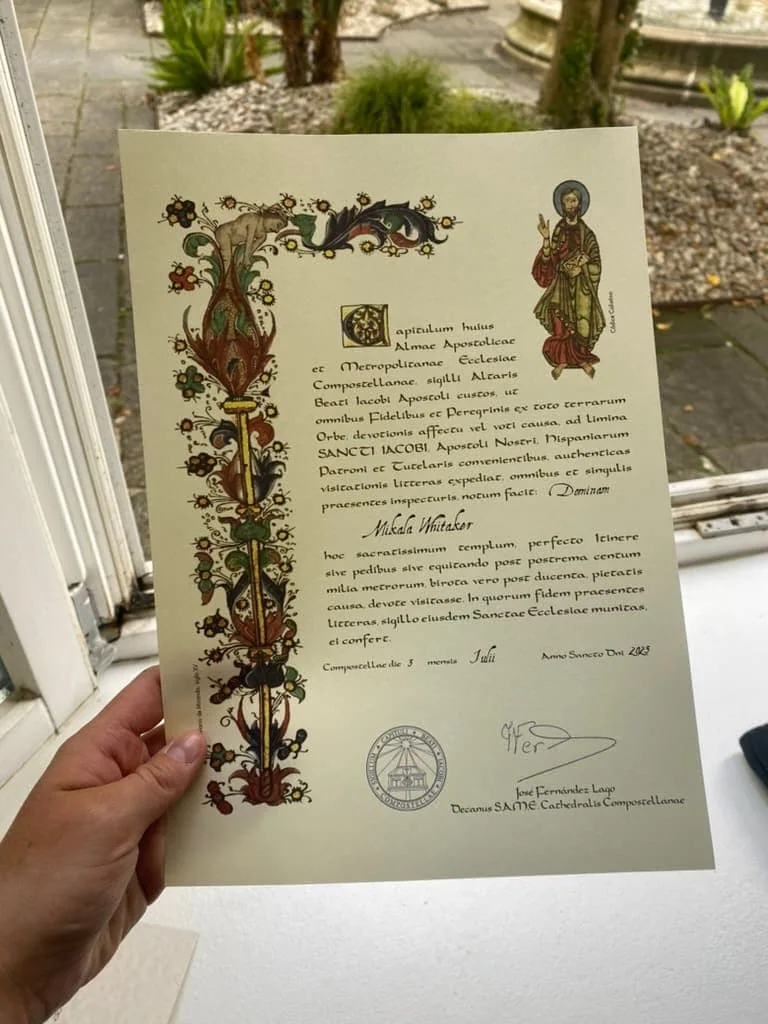
What is the Compostela Certificate?
The Compostela Certificate is an official document confirming that you’ve completed the Camino de Santiago. It’s written in Latin and includes your name and the date you arrived.
Getting stamps in your Camino de Santiago passport will allow you to get this certificate when you arrive in Santiago de Compostela.
How Many Stamps Do I Need to Get the Compostela Certificate?
To get the Compostela Certificate, you must journey the last 100 km of your route on foot or horseback OR the last 200 km by bike. During this time, you must collect at least two stamps per day in your Camino de Santiago passport.
Note that you can complete the Camino de Santiago in stages and still get the Compostela. If you do this, you’ll just want to make sure to get a stamp at your start and end points each time, starting in the same place that you previously ended.
Previously, there were two different versions of the Compostela—one for those doing the Camino for religious purposes and one for everyone else. Things have changed a bit, and I verified with the Pilgrim’s Office that there’s just one certificate now.
There’s still technically a requirement that you must have completed the Camino for religious or spiritual purposes to get the Compostela. However, in recent years, they’ve broadened that requirement significantly, adding having an “attitude of search” as an option.
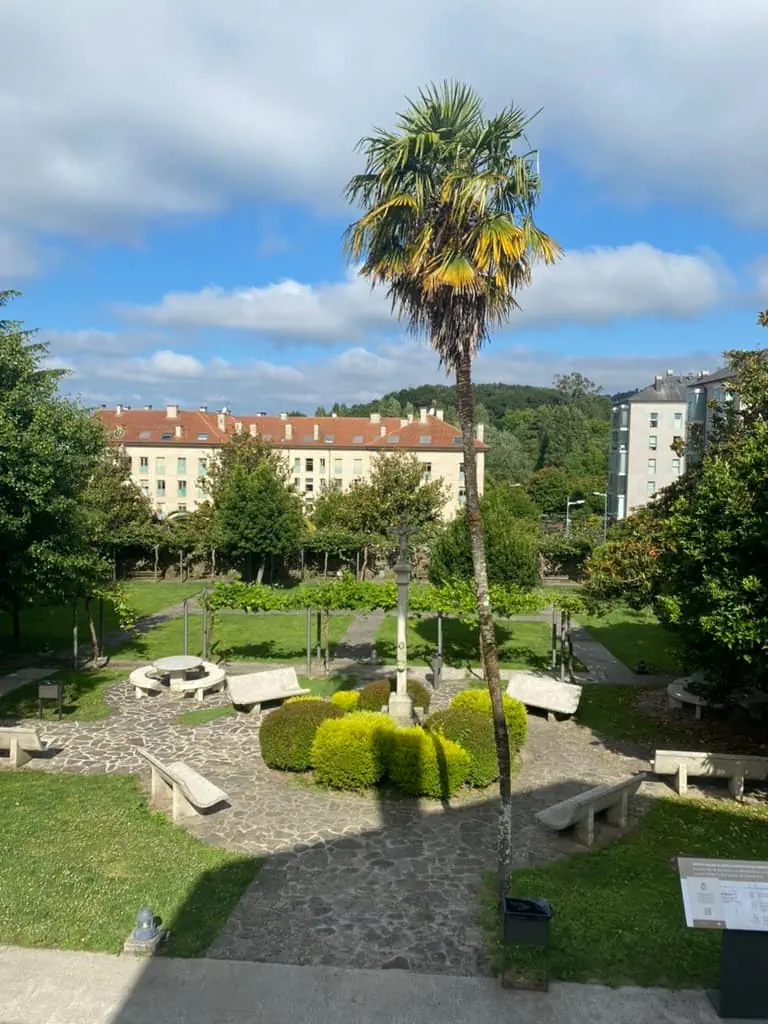
Where Can I Get the Compostela Certificate?
You can collect this certificate at the Pilgrim’s Office in Santiago de Compostela for free. Note that there can often be long lines at the office, but they move people through quickly.
I recommend purchasing a cardboard tube to help protect your certificate as well. They sell them for €2.
If you’re one of the first ten pilgrims to get your Compostela, the Parador Hotel will offer you a free meal ticket for lunch. The pilgrim’s meal is said to be a lovely way to finish the Camino and generally a cool thing to do in Santiago de Compostela.
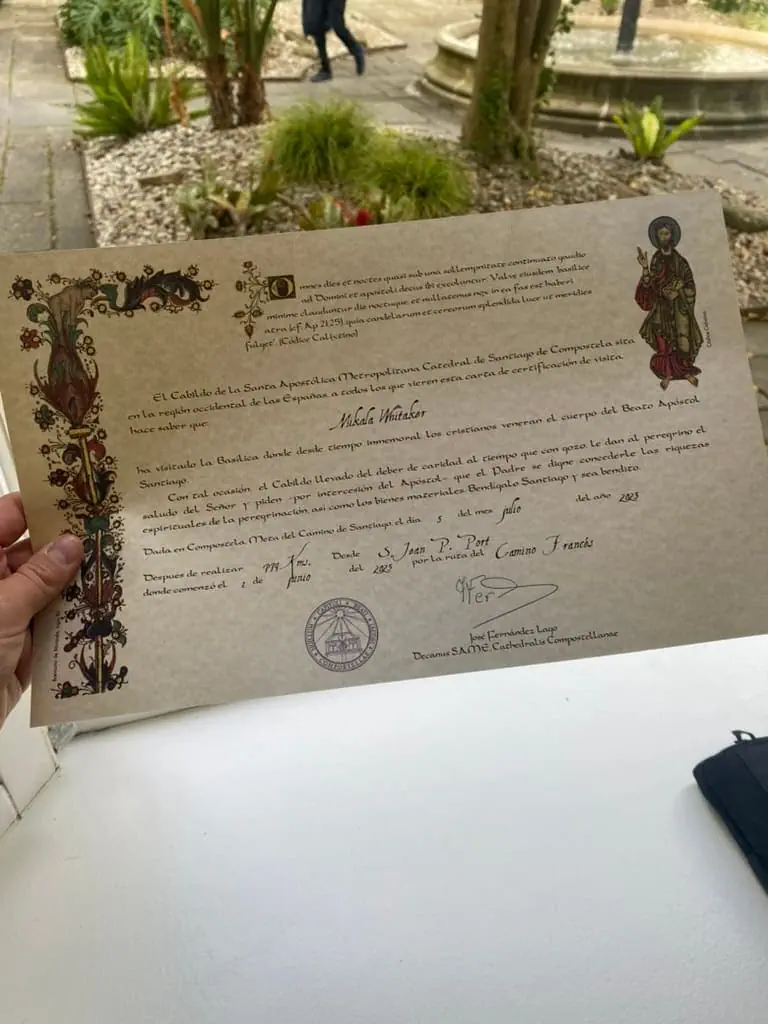
What is the Certificate of Distance?
The Certificate of Distance confirms the exact distance and route you hiked for the Camino de Santiago. There are many different routes and distances, so this is another great way to commemorate your journey.
This certificate can also be collected at the Pilgrim’s Office. It is not free like the Compostela but just costs €3.
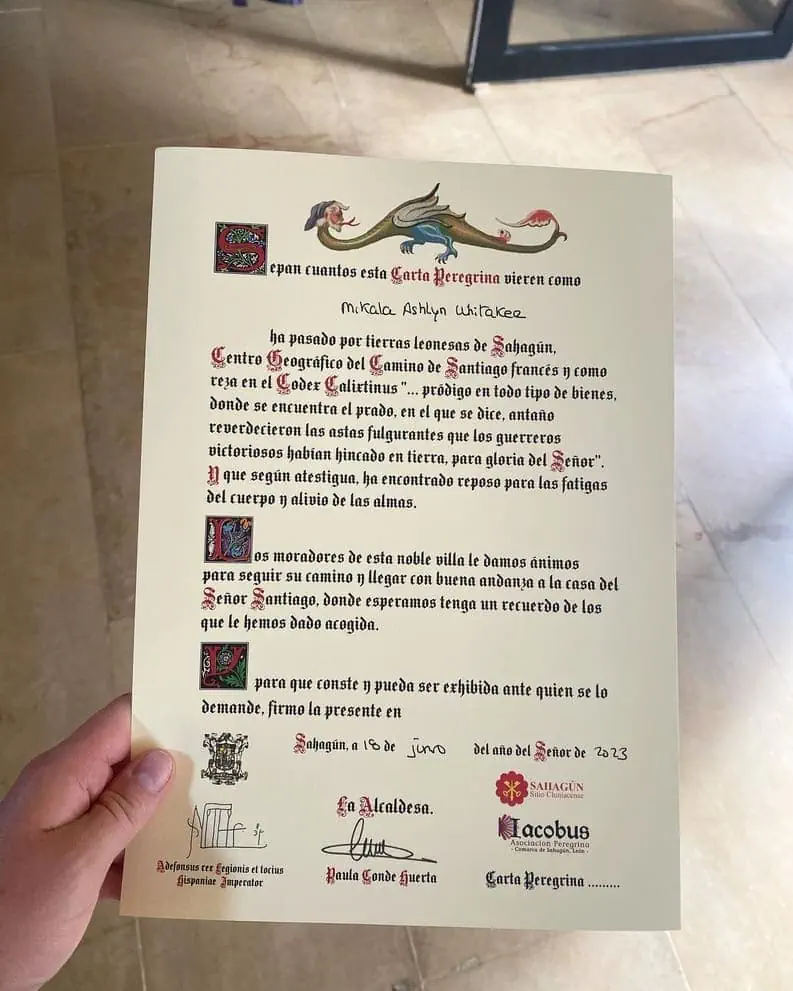
Are There Any Other Certificates?
There are numerous other certificates that you can pick up along the Camino. Here are a few of note:
- Camino Francés Halfway Certificate (Carta Peregrina): Visit the Santuario de la Virgen Peregrina to pick up this certificate.
- Finisterra and Muxía Certificates: Both of these towns offer their own certificates for pilgrims who choose to continue on to the sea. In Finisterra, get your certificate at the pilgrim hostel or Tourism Office. In Muxía, obtain it at the Tourism Office.
- Dual Compostela: If you complete both the Camino de Santiago and Kumano Kodo in Japan, you can get this credential after finishing both. If you’ve done the Kumano Kodo already, then you can get the dual pilgrim certificate when you finish the Camino at the Tourism Office in Santiago de Compostela. You cannot get this certificate at the Pilgrim’s Office.
- The Pedronía: This special certificate is available at the Tourism Office in Padrón for those passing through along the Camino Portugués. The town offers this certificate because its location is believed to be where Saint James’ remains arrived from Jerusalem.
Conclusion: Camino de Santiago Passport
As you can see, the Camino de Santiago passport is part of the fun of the journey and has logistical value as well. If you’re considering doing the Camino, getting the passport, or credencial, is a must and will make your journey all the more special.

